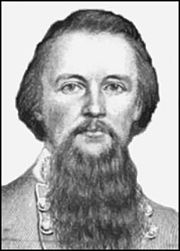| George Burgwyn Anderson | |
|---|---|
 George Burgwyn Anderson drawing drawn in 1862 | |
| Born | April 21, 1831 |
| Died | October 17, 1862 (aged 31) |
| Place of birth | Orange County, North Carolina |
| Place of death | Raleigh, North Carolina |
| Place of burial | Historic Oakwood Cemetery Raleigh, North Carolina |
| Allegiance |
|
| Service/branch |
U.S. Army *Cavalry Confederate States Army *Infantry |
| Years of service |
1852–1861 (USA) 1861–1862 (CSA) |
| Rank |
File:CSAGeneral.png Brigadier General (CSA) |
| Battles/wars | |
George Burgwyn Anderson (April 12, 1831 – October 16, 1862) was a career military officer, serving first in the antebellum U.S. Army and then dying from wounds inflicted during the American Civil War while a general officer in the Confederate Army. He was among six generals killed or mortally wounded at the Battle of Antietam in September 1862.
Early life[]
George B. Anderson, the oldest son of plantation owner William E. Anderson and his wife Frances Eliza Burgwyn, was born near Hillsboro, North Carolina. Anderson was the second cousin of Col. Henry K. Burgwyn of the 26th North Carolina. He entered the Caldwell Institute, where he graduated at the top of his class. While attending the University of North Carolina, he received an appointment to the United States Military Academy and graduated tenth of forty-three cadets in the Class of 1852. He was brevetted as a second lieutenant in the 2nd U.S. Dragoons and trained at the cavalry school at Carlisle Barracks, Pennsylvania.[1] Anderson was promoted to second lieutenant on March 21, 1854.[2]
Military career and marriage[]
Following his training, Anderson was sent to California to assist in the survey of a proposed railroad route before joining his regiment at Fort Chadbourne in Texas. On December 13, 1855, he was promoted to first lieutenant.[2] He commanded his cavalry troop in the march from Texas across the plains to Fort Riley, Kansas. In 1858, he was the adjutant of the regiment while serving in the Utah Territory during the Utah War and promoted to captain.[3] In 1859, he was ordered to Louisville, Kentucky, for duty as a recruiting officer. There, he met and married Mildred Ewing. He also served another stint as Adjutant from August 1858 to September 1859.[2]
Civil War service[]
With the outbreak of the Civil War, Anderson resigned his U.S. Army commission on April 25, 1861, and returned home. The Governor of North Carolina, John Willis Ellis, appointed him as colonel of the 4th North Carolina Infantry on July 16. Anderson capably led his regiment at the Battle of Williamsburg in May 1862 and was rewarded a month later with a promotion to brigadier general on June 9.[2] He was assigned command of a brigade in Maj. Gen. D.H. Hill's division, fighting at the Seven Days Battles and Malvern Hill, where he was wounded in the hand during the Confederate assault. While recovering, he was part of the defenses around Richmond, Virginia in July 1862, serving in the 4th Brigade of Maj. Gen. G.W. Smith's Division.[2]
Maryland Campaign and death[]
Now able to return to active duty, Anderson resumed his brigade command in time for the Maryland Campaign. He fought at the Battle of South Mountain before marching into the Cumberland Valley to Sharpsburg, Maryland, as the Army of Northern Virginia concentrated. During the subsequent Battle of Antietam, Anderson's veteran North Carolinians defended a portion of the Sunken Road (known as "Bloody Lane") against repeated Union attacks. A Minié ball struck Anderson near his ankle, injuring it badly. Anderson was transported to Shepherdstown and then by wagon up the Shenandoah Valley to Staunton, Virginia, to recuperate. He was eventually shipped by train to Raleigh, North Carolina, where he died following surgery to amputate the infected foot.[2] Anderson is buried in Historic Oakwood Cemetery in Raleigh.[2]
Notes[]
References[]
- Eicher, John H., and Eicher, David J., Civil War High Commands, Stanford University Press, 2001, ISBN 0-8047-3641-3.
- Evans, Clement A., Confederate Military History, Vol. III, Atlanta: Confederate Publishing Company, 1899.
- Warner, Ezra J., Generals in Gray: Lives of the Confederate Commanders, Louisiana State University Press, 1959, ISBN 0-8071-0823-5.
External links[]
- National Park Service brief bio of Anderson
- Anderson biography
- "George B. Anderson". Find a Grave. http://www.findagrave.com/memorial/9852. Retrieved 2008-02-13.
The original article can be found at George B. Anderson and the edit history here.